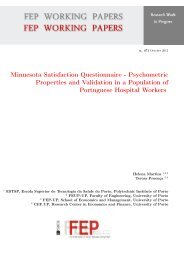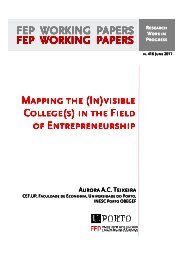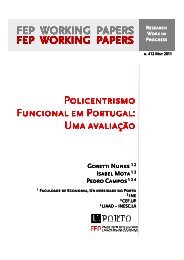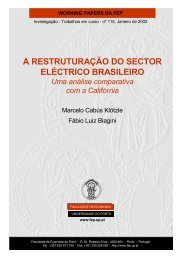FEP - Working Papers - Universidade do Porto
FEP - Working Papers - Universidade do Porto
FEP - Working Papers - Universidade do Porto
You also want an ePaper? Increase the reach of your titles
YUMPU automatically turns print PDFs into web optimized ePapers that Google loves.
7 Appendix<br />
Proof of Lemma 1.<br />
Assume, by way of contradiction, that the prices that maximize the profits of a department<br />
store at L (given the prices at R) are such that p ∈ S2.<br />
(i) We start by considering the possibility of an interior solution, assuming that 0 < ˜xL <<br />
˜x < ˜xR < 1 and that piL �= piR, ∀i ∈ I.<br />
In this case, the profit function is continuous with respect to piL, ∀i ∈ I, in a neigborhood<br />
of p. This implies that the first-order conditions must be satisfied.<br />
In the interior of any branch in S2, the profit of the department store is given by:<br />
� � �<br />
ΠL = ˜xL pjL + ˜xR pjL = ˜xL pjL + (˜xR − ˜xL) �<br />
j∈IR<br />
j∈IL<br />
j∈I<br />
Using the fact that ˜x − ˜xL = ˜xR − ˜x, we can write:<br />
ΠL = ˜x �<br />
�<br />
�<br />
pjL + (˜x − ˜xL) pjL − �<br />
j∈I<br />
The first-order conditions, for i ∈ IR, are:<br />
∂ΠL<br />
∂piL<br />
= 0 ⇔ ˜xL = 1<br />
t<br />
j∈IL<br />
j∈IR<br />
pjL<br />
�<br />
�<br />
pjL ⇔ 2 �<br />
pjL = t + �<br />
j∈IR<br />
while, for i ∈ IL, the first-order conditions are:<br />
∂ΠL<br />
∂piL<br />
= 0 ⇔ ˜xR = 1<br />
t<br />
j∈IR<br />
j∈IL<br />
.<br />
j∈IR<br />
�<br />
pjL ⇔ 2 �<br />
pjL = �<br />
j∈IL<br />
j∈IL<br />
j∈IL<br />
pjR,<br />
pjR.<br />
Using the two last equalities, we can rewrite the expression of ΠL as follows:<br />
ΠL = ˜xPL − t<br />
2 (˜x − ˜xL) .<br />
If the department store had chosen prices such that p ∈ S1 with the same PL, its profit<br />
21<br />
pjL.











